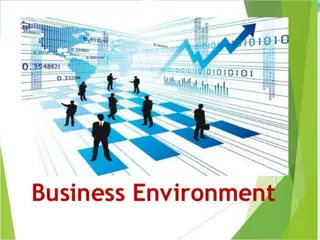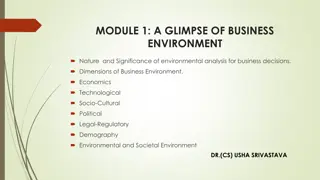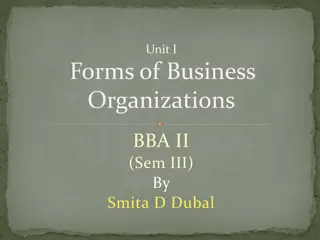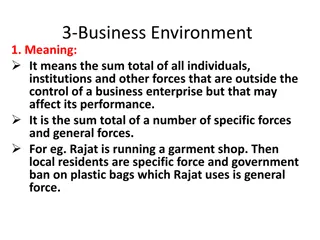Understanding Business Environment and Objectives
Business encompasses a wide range of activities related to the production and distribution of goods and services, influenced by various interpretations from consumers, governments, and environmentalists. It involves activities like buying, selling, manufacturing, and service provision, all aimed at generating profit while providing value to society. Features like dealings in goods and services, production and exchange, profit motive, and risk and uncertainty define the nature of businesses. The concept of business includes the creation of form, time, and place utility, regularity, continuity, and the dynamic nature of government control. Goods and services are categorized into consumer goods and producers' goods, with the former meant for direct consumption and the latter for further production purposes.
Download Presentation

Please find below an Image/Link to download the presentation.
The content on the website is provided AS IS for your information and personal use only. It may not be sold, licensed, or shared on other websites without obtaining consent from the author. Download presentation by click this link. If you encounter any issues during the download, it is possible that the publisher has removed the file from their server.
E N D
Presentation Transcript
Business Environment Business Environment
Business Objectives Business Objectives Chapter : 1
Business Business is a generic term which comprises of all primary and ancillary activities which are involved in the production and distribution of goods and services. The term business has varied interpretations. For a consumer, business is supply of goods and services required for daily life. For the government , business is an important source of revenue. For environmentalist business is responsible for pollution. Basically all socially desired economic activities adopted to earn profit can be defined as Business .
Definition The activities of buying and selling goods, manufacturing goods or producing services in order to make profit. Business is an institution organised and operated to provide goods and services to society under the incentive of private gains. Business is a human activity directed towards producing or acquiring wealth thru buying and selling activities.
Features of Business Dealings in Goods and Services Production and/or Exchange Creation of Form, Time and Place Utility Regularity and Continuity in Dealings Profit Motive Risk and Uncertainty involved Creative and Dynamic Government Control 1. 2. 3. 4. 5. 6. 7. 8.
1. Dealings in Goods and Services 1. Dealings in Goods and Services Goods produced or exchanged, may be consumers' goods, such as bread, rice, cloth, etc. or producers' goods such as machines, tools, etc. The consumer goods are meant for direct consumption, either immediately, or after undergoing some processes,. The producers' goods are meant for being used for the purposes of further production. Producers goods are also known as capital goods. Services include supply of electricity, gas, water finance, insurance, transportation, warehousing, etc.
2. Production and/or Exchange Production and/or Exchange Every business is concerned with production and exchange of goods and services for value (money). Thus, goods produced or purchased for personal consumption or for presenting to others as gifts do not constitute business, because there is no sale or transfer for value. For example, if a person cooks at home for personal consumption, it is not business activity. But, if he cooks for others in his 'dhaba', or restaurant and receives payment from them, it becomes his business.
3. Creation of form, time and place utility Creation of form, time and place utility All business activities create utilities for the society. Form utility is created, when raw materials are converted into finished goods and services. Place utility is created, when goods are transported from the place of production to the place of consumption. Storage of goods creates Time utility, this helps in preserving the goods, when not required and making them available, when demanded by the consumers.
4. Regularity and Continuity in Dealings Regularity and Continuity in Dealings Regularity of economic transactions is the essence of business. There should be continuity, or regularity of exchange of goods and services for money. An isolated transaction cannot be called a business. For example, if a person sells his flat and earns some profits, it cannot be called a business. But, if he purchases and sells flats regularly to earn his livelihood, it will be called his business.
5. Profit Motive Profit Motive The chief objective of a business is to earn reasonable profits or 'surplus'. The survival of a business depends upon its ability to earn profits. Every businessman wants to earn profits, to get return on his capital and to reward himself for his services. Actually, profit is the spur that helps in the continuation of the business. Profit is also essential for growth. Recreation clubs and religious institutions cannot be called business enterprises, as they have nothing to do with the profit motive.
6. Risk and Uncertainty involved Business activities are always risky and uncertain. Every businessmen has to undertake substantial risks in his business. A business enterprise may suffer loss due to a number of possible reasons such as changes in technologies, changes in consumer tastes and preferences, market competitions etc.
7. Government Control Government has to keep a watch on overall business activities and see that they move in the right direction. For this , government control is a must. This may be in the form of suitable laws, rules, regulations, sanctions and so on.
8. Creative & Dynamic Business activities are creative as they are normally for the convenience of consumers. They are ever changing. This is natural as business operates under changing economic, social, and technological environment. Modern business is dynamic as it has to change and adjust its activities as per the environmental factors.
BUSINESS OBJECTIVES BUSINESS OBJECTIVES
WHAT ARE BUSNIESS OBJECTIVES? Every rational human activity needs well defined objectives. Business is no exception to this rule. Profit making, social recognition and business growth are some universally accepted Business objectives . Objectives indicate the destination towards which the business unit desires to move. Running a business unit without well defined objectives is like journey without fixed destination. On the other hand objectives means giving a definite and clear direction to the activities of the organisation.
Objectives are the ends which a business unit desires to achieve. They are future destinations of an organisation. They act as focal points before the business enterprise. Objectives are normally decided by the top management of the company. Lower level are too busy in routine business activities and do not have time to look after overall business objectives. Top management should review the objectives periodically and give proper direction to the whole organisation in this regards. Objectives are not stable over a long period. In fact they are redefined periodically as per the environmental changes.
Definitions Objectives are the ends towards which activities of any enterprise or department or project within it are aimed. Objectives are the goals, aims or purpose that organisations wish to achieve over varying period of time. A specific result that an organisation aims to achieve within a time frame and with available resources.
Features/Characteristics of Features/Characteristics of Business Objectives Business Objectives Lengthy Process Specific Challenging Clear and easily understandable Time Frame Profitability Flexible Hierarchy of Objectives Qualitative and Quantitative 1. 2. 3. 4. 5. 6. 7. 8. 9.
Importance/Significance of Objectives in Importance/Significance of Objectives in Business Management Business Management Objectives justify the existence : Every enterprise needs its own objectives. The objectives offer social justification for its existence. A business enterprise lacks moral right to operate if there is nothing to achieve. Facilitates planning process : Business objectives facilitates management process which includes planning, organising, staffing etc. Management which does not define its objectives would not know where it wants to go and will become a victim of confusion. Objectives facilitates planning process.
Define relationship with its environment : Objectives suggest what the organisation desires to achieve for its employees, customers and the society at large under the prevailing circumstances. Well defined objectives give convenience to the organisation and the outsiders also. Enable managers to work with confidence : Objectives guide and motivate managers and thereby enable them to manage business activities with confidence. Managers set the objectives for them and also for the organisation and see that they are achieved within the fixed time limit.
Facilitates correct Decision making : Objectives help to coordinate strategic decision making in the organisation. Decision making process becomes easy, quick and correct in the light of the objectives. Provides standard for performance appraisal : Objectives state the targets to be achieved within a specific time limit. They can be used by judging actual performance. Objectives provide clear cut basis for evaluating the performance of an organisation.
Brings uniformity in the activities of departments : Objectives act as connecting link and bring integration in the activities of different departments such as production, sales, finance etc. Broad objectives are divided into smaller parts and made applicable to different departments. This ensures coordination and uniformity in the working of different departments.
Threefold / Organic / Basic Objectives of Business
Organic/ Threefold /Basic Objectives of Business A business unit has to give attention to 3 basic objectives. 1. Survival 2. Growth 3. Recognition / Image
Survival Survival Survival in the business is the basic objective of a business unit. It is classified as organic/primary objective of business. Survival comes first and profit comes next. Other objectives can be thought of only if the business unit stands independently in the market. No company can take its survival for granted in the present complex and highly competitive business environment. Constant monitoring of the business situation and strategic planning are necessary for survival in the competitive business environment. For survival, full utilization of available resources, adjustment with the environmental forces, enhancing competitive capacity and securing support of various social groups are necessary. Profit And Survival are supplementary, as survival in business is just not possible without earning profits.
Growth Growth Growth is the second major business objective. It is next to survival as a business unit can go for expansion only when it gets adequate stability. Growth means expansion of business activities by introducing new products, new plants, expansion of marketing activities, diversification in new areas, foreign collaboration, takeovers etc. A business unit can have expansion only when its survival base is sound. Survival is essential for growth. Expansion and growth bring more profit, more business and popularity to a business unit. Long term planning is necessary for orderly and multi dimensional growth of an enterprise.
Recognition /Image/ Prestige Recognition /Image/ Prestige A business unit desires to have social recognition i.e. market reputation. This objective can be described as favourable image building of the enterprise among consumers and other social groups. After securing stable survival and growth an enterprise will like to give attention to image building and market standing. This can be done by sponsoring sports, cultural activities, educational project and so on. The basic purpose is to have a good public image. The enteprise feels that others should have confidence on the company and treat it as an honest and consumer friendly company. Prestige generally comes due to standard quality of its products, regularity in their supply, reasonable prices and satisfactory service to consumers. Recognition indicates public confidence on an enterprise. Such recognition is only possible after a long period of useful service to the society.
Steps in formulating Business Objectives
Consider Environmental Factors Consider resources of the enterprises Consider individual dominance Consider value system Consider past objectives Determine final objectives 1. 2. 3. 4. 5. 6.
Dynamics of Business & its Environment
Environment The word Environment is derived from the French word Environ which means surrounding . Environment means the surrounding within which someone or something exists. It is like the climate or culture which surrounds us. Man and his environment are closely connected and related.
Business Environment Business Environment A business organisation does not exist in a vacuum. It is in fact dependent on the environment. For efficient and rational decision making a business organisation must understand its relationship with its environment. Business has to operate within the situation created by the environmental factors/forces. It has to adjust its activities as per the environmental changes. Such adjustability is essential for survival and growth of business.
Business environment may offer opportunities for the firm or threats to the firm. The changing needs of customers and new innovations in the market are a part of the business environment. The challenge for businesses in this technological era is not to enter the market but to survive in the market.To survive in the market means to adapt to the changes as fast as possible.To adapt to the changes means to be aware of the business environment. A business firm is an open system and it affects and is affected by outside events and factors which make up the external environment.
A business firm is also affected by a number of internal factors, which are forces inside the business organisation. While the policy makers and the managers at the top level are concerned with the external environment, the middle level and lower level management are more concerned with the internal environment.
Definition The combination of internal and external factors that influence a company's operating situation. The total of all things external to firms and individuals, which affect their organisation and operations. The aggregate of all conditions, events and influences that surround and affect it.
FEATURES OF BUSINESS ENVIRONMENT FEATURES OF BUSINESS ENVIRONMENT Business environment is the sum total of all factors that are internal and external to the business firm and that greatly influence their functioning. It covers factors like customers, competitors, suppliers, government, and the social, cultural, political, technological and legal conditions. The business environment is dynamic in nature, that means, it keeps on changing. Business enterprises have to study these changes constantly and adjust its activities accordingly. The changes in business environment are unpredictable. It is very difficult to predict the exact nature of future happenings and the changes in economic and social environment. 1. 2. 3. 4.
Business Environment differs from place to place, region to region and country to country. Ex : Political conditions in India differ from those in Pakistan. Taste and values cherished by people in India and China vary considerably. Business Environment provides the framework within which business activities are to be conducted. Business organisation have limited capacity to influence Business Environment. It is the environment that influences business. Environment creates problems and threats before business units, in some cases new opportunities for growth may be created. Thus Environment means new opportunity and threats. 6. 7. 8. 9.
Components / Types/ Areas of Components / Types/ Areas of Business Environment Business Environment PESTLE P - Political Environment E Economic Environment S - Socio Cultural Environment T -Technological Environment L - Legal Environment E - Ecological Environment
1. Political Environment This includes the political system, the government policies and attitude towards the business community and the unionism. All these aspects have a bearing on the strategies adopted by the business firms. The stability of the government also influences business and related activities to a great extent. It sends a signal of strength, confidence to various interest groups and investors. Further, ideology of the political party also influences the business organisation and its operations
Elections, assurances given by political parties, donations to political parties, political developments like death of an important political leader, political scandals, corruption charges on leading political parties, war etc are major political factors which affect the political environment. The success & growth of business depends upon stable, dynamic, honest, people oriented government, proper law and order situation, strong party in power, responsible opposition and responsible role of press and publicity. Political friendship & diplomatic relations help in growth of trade.
Countries with stable government and political system have enjoyed successful and efficient business operations. USA is the best example. Business and Politics are inseparable. Business cannot remain unaffected by politics.
Features Influencing factors Favorable or Unfavorable Sensitive and flexible Closely related to Economic environment Importance of stable Political environment
2. Economic Environment 2. Economic Environment Economic conditions, economic policies and economic system are the factors that constitute the economic environment. It is multi dimensional in nature & includes all factors connected with the working of the economic system. Economic environment includes investment trends, inflation, monetary policy, fiscal policy, budgetary policies, business laws, industrial licensing, foreign exchange policies, Exim policy, labour policies, balance of trade, balance of payment, economic planning, commercial policies etc. Economic environment is basically the net result of economic policies of the government.
Businessmen have to study the prevailing economic environment and adjust their business plans accordingly. Favourable business environment bring rapid expansion of business activities including marketing, manufacturing, exporting and so on. Economic Environment is supplementary to political environment and is influenced by political decision and political events.
Features of Economic Environment Influencing factors. Multi Dimensional in nature. Influential role of government in shaping economic environment. Limited influence of business on economic environment.
3. 3. Socio Cultural Environment Socio Cultural Environment Society includes different social groups i.e. consumers, investors, local community and employees. The needs and expectations of these social groups create Social Environment for business. Social Environment is supplemented by cultural environment which is the result of cultural factors as cultural values and beliefs, morals, art, customs, religion and so on. Progressive changes takes place in cultural aspects ex festivals, music, dance etc this creates demand for new products and changes in the demand for existing ones.
Even changes in fashions, lifestyles, religious and cultural festivals, marriage, birth etc needs to be studied by businessmen in order to adjust business activities as per the change in the cultural environment. Thus these social norms have the influence on business activities. This is natural as business needs social support for its survival and growth. For example, during festive seasons there is an increase in the demand for new clothes, sweets, fruits, flower, etc. Nestle brews a very large variety of instant coffee to satisfy different national tastes. Even when people of different cultures use the same product. Color : Blue : feminine and warm in Holland , but masculine and cold in Sweden.
Features Influencing factors. Dynamic nature. Special significance. Growing strength of consumerism Importance of adjustment.
4. Demographic Environment 4. Demographic Environment This refers to the age, sex, family size, density, distribution , standard of living and growth rate of population. All these factors have a direct bearing on the demand for various goods and services. For example a country where population rate is high and children constitute a large section of population, then there is more demand for baby products. Similarly the demand of the people of cities and towns are different than the people of rural areas. The high rise of population indicates the easy availability of labour. These encourage the business enterprises to use labour intensive techniques of production.























